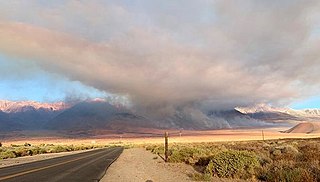Psychomastatix deserticola is a species of grasshopper in the family Eumastacidae. It is endemic to the United States. It is known commonly as the desert monkey grasshopper.

Trimerotropis is a genus of band-winged grasshoppers in the family Acrididae. There are at least 50 described species in Trimerotropis.
Psychomastax deserticola, the desert monkey grasshopper, is a species of monkey grasshopper in the family Eumastacidae. It is found in North America.
Psychomastax is a genus of monkey grasshoppers in the family Eumastacidae. There are at least four described species in Psychomastax.

Trachyrhachys is a genus of band-winged grasshoppers in the family Acrididae. There are at least four described species in Trachyrhachys.

Metator pardalinus, known generally as the blue-legged grasshopper or pard grasshopper, is a species of band-winged grasshopper in the family Acrididae. It is found in North America.

Opeia is a genus of slant-faced grasshoppers in the family Acrididae. There are at least two described species in Opeia.
Mestobregma is a genus of band-winged grasshoppers in the family Acrididae. There are at least three described species in Mestobregma.
Psychomastax robusta, the robust monkey grasshopper, is a species of monkey grasshopper in the family Eumastacidae. It is found in North America.
Nomotettix is a genus of pygmy grasshoppers in the family Tetrigidae. There are at least three described species in Nomotettix.
Cordillacris is a genus of slant-faced grasshoppers in the family Acrididae. There are at least two described species in Cordillacris.
Ageneotettix is a genus of slant-faced grasshoppers in the family Acrididae. There are at least three described species in Ageneotettix.
Bruneria is a genus of slant-faced grasshoppers in the family Acrididae. There are at least three described species in Bruneria.
Trimerotropis leucophaea, the inyo blue-wing grasshopper, is a species of band-winged grasshopper in the family Acrididae. It is found in North America.
Anconia is a genus of band-winged grasshoppers in the family Acrididae. There are at least two described species in Anconia.
Acrolophitus maculipennis, known generally as the Texas point-head grasshopper or black fool grasshopper, is a species of slant-faced grasshopper in the family Acrididae. It is found in Central America, North America, and Mexico.

Cibolacris is a genus of slant-faced grasshoppers in the family Acrididae. There are at least four described species in Cibolacris.
Psychomastax psylla, the San Jacinto monkey grasshopper, is a species of monkey grasshopper in the family Eumastacidae. It is found in North America.
Trimerotropis inyo, the inyo grasshopper, is a species of band-winged grasshopper in the family Acrididae. It is found in North America.

The Taboose Fire is a wildfire currently burning in Inyo National Forest, southwest of Big Pine and northwest of Aberdeen in Inyo County in the state of California, in the United States. The fire started September 4, 2019 and as of October 7, it has burned 10,296 acres (4,167 ha) and is 75 percent contained. The cause of the fire was lightning. Select trails, campgrounds and roads in Inyo National Forest, Sequoia National Park and Kings Canyon National Park have been closed due to the fire. The community of Baxter Ranch remains under mandatory evacuation.






